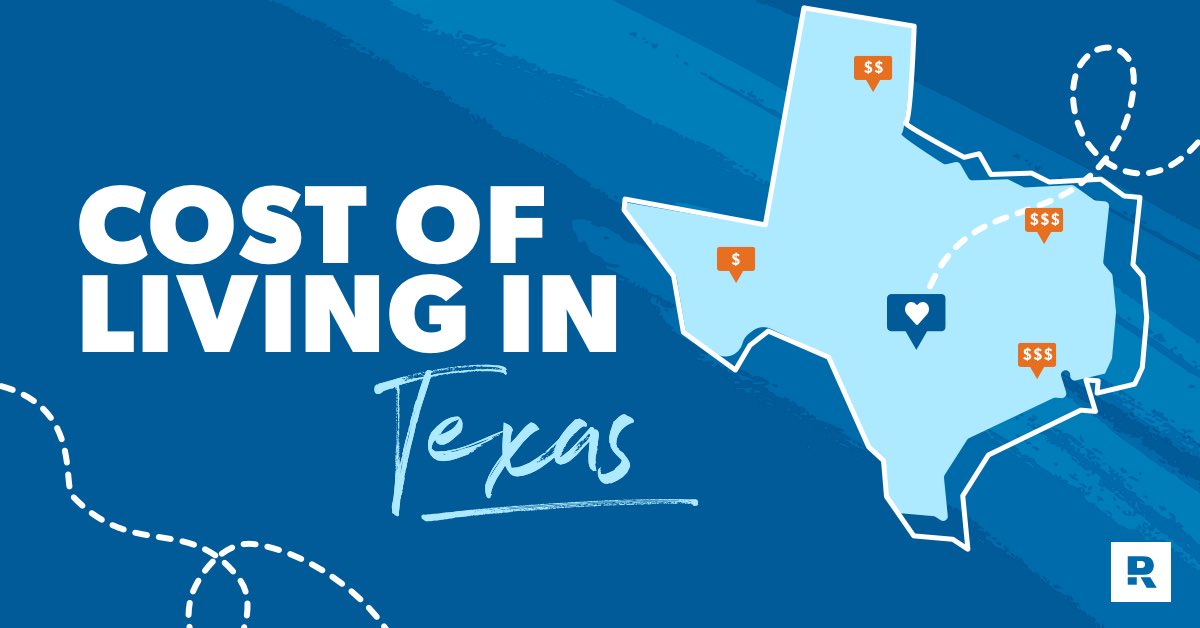
Key Takeaways
- The cost of living in Texas is about 9% lower than the national average.
- Among individual Texas cities, the cost of living ranges from 20% lower to 8% higher when compared to the average U.S. city.
- More Californians are moving to Texas than the other way around because the cost of living is considerably less.
So, you’re dreaming of moving to Texas—and what’s not to love? You can rock out at free live music venues in Austin, cheer on the Dallas Cowboys, remember the Alamo at the Alamo, and eat all the brisket and Tex-Mex your heart desires.
Find expert agents to help you buy or sell a home.
If you want to know if you can afford to live in the Lone Star State, you’d have to compare the cost of living in your current city with the Texas city of your dreams. To help you make a confident decision on whether Texas is the right move for you cost-wise, we’ll show you how much Texas charges for “super fun” grown-up stuff like housing, food, taxes and utilities.
Let’s giddyup!
What’s the Average Cost of Living in Texas?
Everyone knows everything’s bigger in Texas. But does bigger mean more expensive? Well, as it turns out, the cost of living in Texas is surprisingly affordable! In fact, the average cost of living in Texas is 9% lower than the national average.
Keep in mind, Texas is the second-largest state in the U.S.—behind only Alaska (but don’t tell Texans that)—so there’s a wide range. Some Texas cities rank from 20% lower to 8% higher in cost when compared to the average U.S. city.
How do we know? We looked at the Cost of Living Index (COLI) published quarterly by the Council for Community and Economic Research (C2ER). The COLI compares 23 cities in Texas with hundreds of other cities around the country. A number below 100 means Texas has a lower cost of living than the U.S. average for that category—take a look!
|
Cost of Living Category |
Texas |
U.S. |
|
Total |
91 |
100 |
|
Housing |
78 |
100 |
|
Utilities |
103 |
100 |
|
Groceries |
96 |
100 |
|
Transportation |
93 |
100 |
|
Health Care |
96 |
100 |
|
Miscellaneous |
95 |
100 |
Unless otherwise stated, all the numbers in this article come from the COLI. To better understand this index, let’s take a closer look at each category.
Housing
Okay, let’s start with the housing market. In the summer of 2025, median home prices in Texas were $375,000—about 15% lower than the national median of nearly $440,000.1 Meanwhile, the median monthly rent for a two-bedroom apartment ($1,252) was nearly 10% lower than the national median of almost $1,400.2
With prices like those, you might be wondering why you haven’t ridden off into the Texan sunset sooner! Well, don’t forget—costs aren’t the same everywhere in Texas. When you consider total housing cost factors, Texas ranges all the way from 43% lower than the national average in the southern city of McAllen to 9% higher in the city of Plano, north of Dallas.
To find the Texas city that fits your budget, check out the cost differences between some of the best places to live in Texas:
|
City in Texas |
Median Home Price3 |
Median Apartment Rent*4 |
|
$499,000 |
$1,473 |
|
|
$359,900 |
$1,242 |
|
|
$430,000 |
$1,483 |
|
|
$299,000 |
$1,085 |
|
|
$365,000 |
$1,360 |
|
|
$440,000 |
$1,883 |
|
|
$330,000 |
$1,244 |
*Median monthly rent prices refer to two-bedroom apartments.
Don’t buy or sell without an agent you can trust.
There are RamseyTrusted real estate agents all over the country who are ready to help you win.
Utilities
Utility costs like energy and phone service in Texas range from 17% lower than the national average in San Marcos to 27% higher in Harlingen. Denton is somewhere in the middle range among Texas cities for utility costs at 1% higher than the national average.
Trust us, with that stifling Texas summer heat, you’re going to want to crank up the AC.
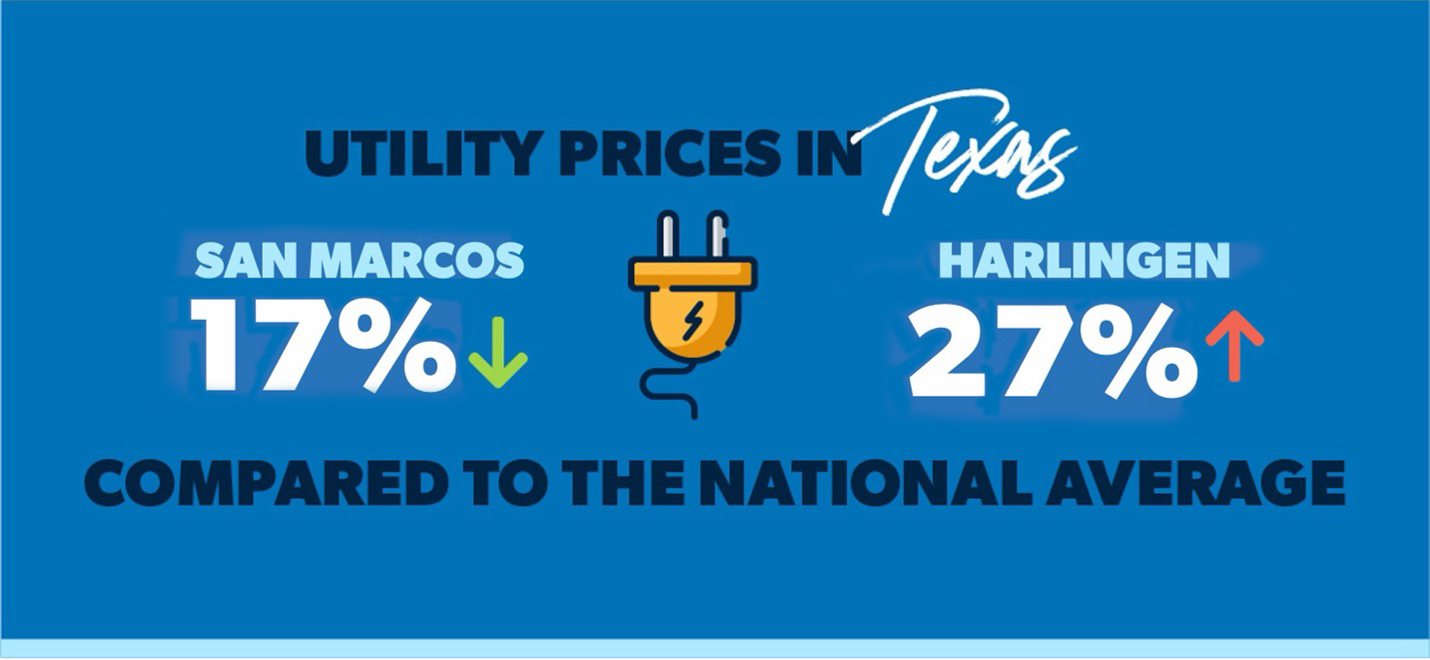
Groceries
Grocery prices in Texas have a much narrower range—in a good way. No matter where you land, they’re going to be at least slightly below the national average. That’s right . . . no Texas city on the COLI list has higher-than-average grocery prices! They range from 8% lower than the national average in Waco to 1% lower in Fort Worth.
The capital city of Austin may have a reputation as a weird city inside and outside of Texas, but it’s right down the middle with grocery costs—at 4% below the national average.
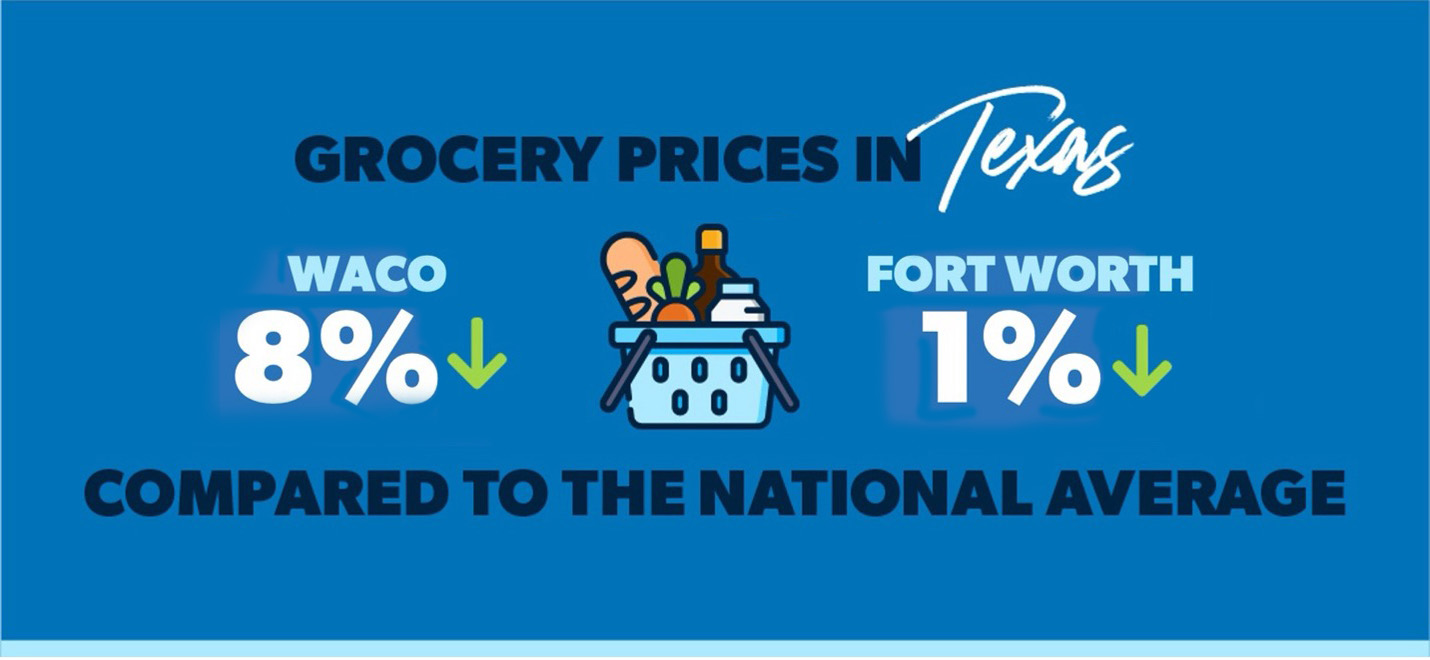
Transportation
Rev up your engines! Texas transportation costs range from 16% lower than the national average in Harlingen to 12% higher in the border city of El Paso. Fort Worth slides into the middle range for transportation costs among most Texas cities, which is 8% lower than the national average.
Since a personal vehicle is the main way to get around in Texas, you’ll want to keep transportation costs low by getting the right insurance. Talk to one of the independent insurance agents we recommend to see if bundling your auto policy can help you save.
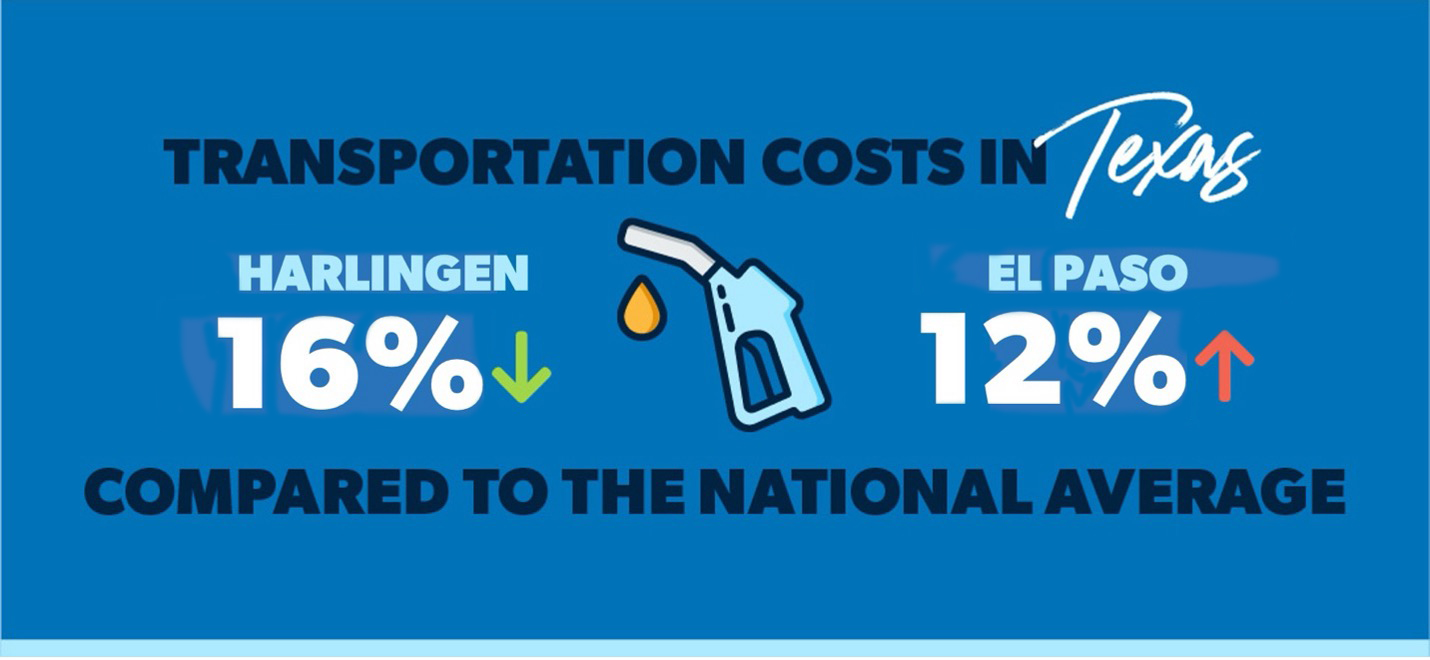
Health Care
Texas health care costs range from 27% lower than the national average in McAllen to 25% higher in Plano. Meanwhile, El Paso sits in the middle range among Texas cities, with health care costs at about 2% below the national average. Not too shabby.
Here’s a breakdown of how El Paso health care costs compare to the average city in the country:
|
Health Care Type |
El Paso Cost |
Average U.S. City Cost |
Cost Difference |
|
General doctor |
$133 |
$154 |
14% less |
|
Dentist |
$125 |
$123 |
2% more |
|
Eye doctor |
$151 |
$139 |
9% more |
|
Ibuprofen |
$11 |
$11 |
0% |
|
Prescription drug |
$23 |
$23 |
0% |
Taxes
Guess what? Texas has no state income tax!5 That’s right—if you don’t mess with Texas, Texas won’t mess with your taxes. Well, at least it won’t touch your paycheck. Texas still has a state sales tax rate of 6.25%—or 8.2% if you include its average local rate. That percentage ranks Texas as the 13th highest in the country for total sales tax—cue the eye roll.6
If all this tax talk makes you quake in your boots, don’t worry. You can find out exactly how moving to Texas will impact your taxes by connecting with a RamseyTrusted® tax advisor.
Miscellaneous Goods and Services
Miscellaneous costs refer to a wide range of goods and services including things like common restaurant foods, clothing, entertainment, activities and personal care. In Texas, these costs range from 24% lower than the national average in Harlingen to 10% higher in Plano. If this was an awards show, Harlingen would be cleaning up!
Lubbock, the “Hub City” and birthplace of Buddy Holly, represents the median of Texas cities for miscellaneous costs—3% lower than the national average. In Lubbock, you can order a pizza for $11, get a haircut for $31, and buy a shirt for $45. For reference, those prices are $13, $28 and $39 for the average U.S. city, respectively.
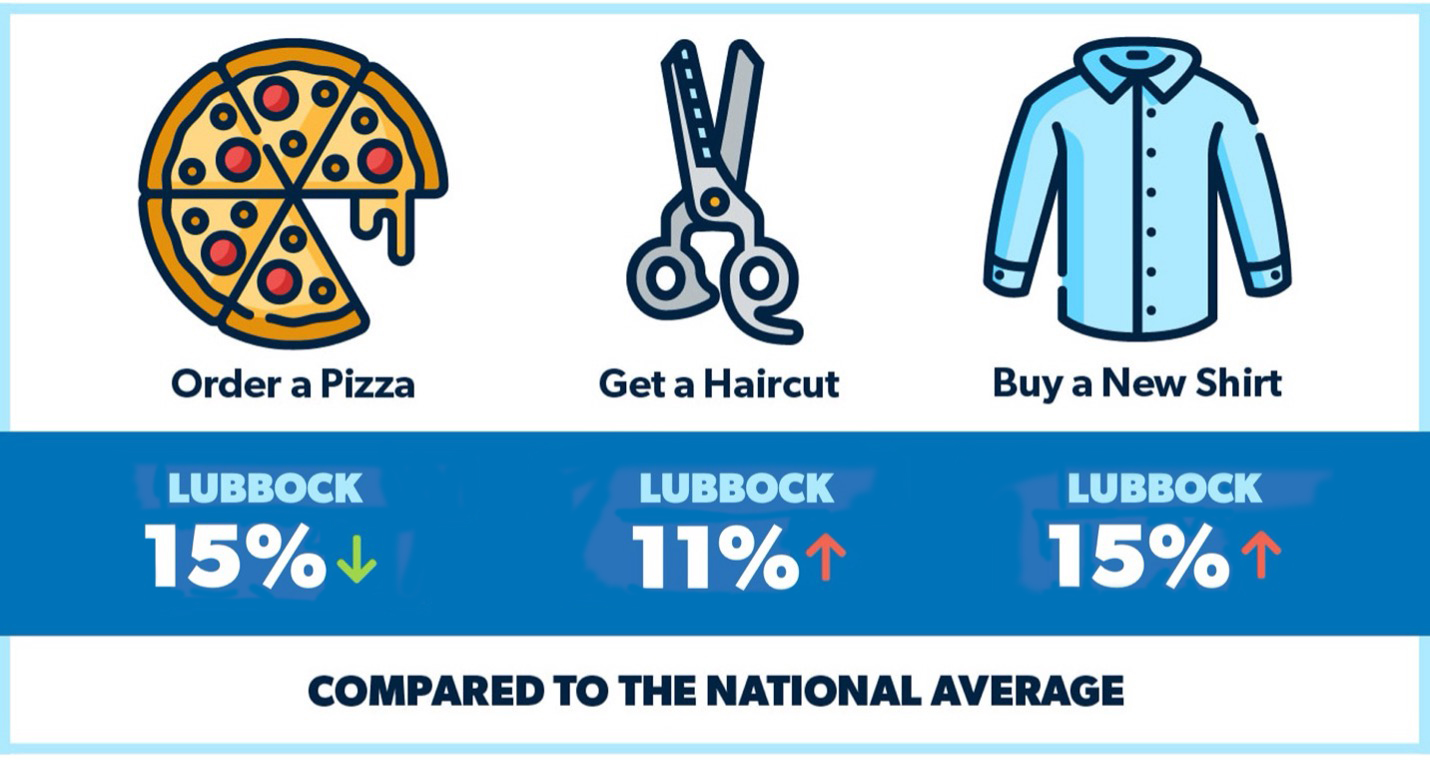
How Much Do You Need to Live Comfortably in Texas?
In Texas, the median household income is $79,721.7 But if you make that much, it doesn’t automatically mean you can afford to live anywhere in Texas—at least not comfortably.
If you want to live comfortably in the Lone Star State, first make sure you can afford your biggest expenses—namely, your housing costs.
Whether you decide to rent or buy in your new city, stick to the 25% guideline—never move into a home with a monthly payment that’s more than 25% of your take-home pay.
For home buyers getting a mortgage, that 25% limit includes principal, interest, property taxes, home insurance and private mortgage insurance (PMI)—and don’t forget to consider homeowners association (HOA) fees. Use our Mortgage Calculator to enter your down payment amount and try out different home prices within your budget.
For a mortgage you can pay off fast, talk to our friends at Churchill Mortgage about getting a 15-year fixed-rate conventional loan. Any other type of mortgage will cost you extra in interest and fees and keep you in debt for decades. Trust us, following the 25% guideline will give you enough room in your budget to balance housing costs and your other living expenses with ease.
What’s the Cost of Living in Texas vs. California?
In case you’re curious, more people are moving to Texas from California than from any other state. In fact, 93,970 Californians moved to Texas in 2023. Meanwhile, only 38,732 Texans moved to California, according to the latest data by the U.S. Census Bureau.8
Why are so many Californians moving to Texas? It could be because the average cost of living in Texas is significantly lower than the cost of living in California (shocker!). To see for yourself, let’s use the COLI to find out what it’d be like, cost-wise, moving from a popular city in California to a popular city in Texas:
|
Cost of Living |
Austin, TX |
San Francisco, CA |
Cost Difference |
|
Total |
95 |
160 |
41% less |
|
Housing |
95 |
246 |
61% less |
|
Utilities |
100 |
150 |
33% less |
|
Groceries |
96 |
114 |
16% less |
|
Transportation |
95 |
141 |
33% less |
|
Health care |
89 |
126 |
29% less |
|
Miscellaneous |
93 |
122 |
24% less |
Wow! As you can see, moving to a new city with a lower cost of living can be an incredible way to transform your financial life! But a big move like that isn’t the right choice for everyone—there are always more pros and cons to consider.
Compare the Cost of Living in Texas With Your Current City
Now you know the cost of living in Texas—but can you afford it? If you want to be sure, try our free Cost of Living Calculator to determine how much more or less expensive it would be for you to live in the Texas city that’s calling your name.
If Texas has a higher cost of living than you can currently afford, not all hope is lost. Try one of these ideas:
- Adjust your standard of living.
- Try to bump up your salary when you find a new job.
- Move to an affordable zip code that’s near your desired city.
Ready to Move to Texas?
Does all this cost of living talk make you want to get up and find your own little patch of heaven in the Lone Star State? Then talk with a local Texas real estate agent to find that perfect home on the range that’s also in your price range.
For a quick and easy way to find real estate agents in Texas and your current city, try our RamseyTrusted program. The agents we recommend have earned the Ramsey team’s shield of approval by always serving with excellence and putting your needs first.
Next Steps
- Figure out where you want to live in Texas and if you can afford it.
- Estimate how much it’ll cost to move, and make a plan to save up that amount.
- Work with a local RamseyTrusted real estate agent to find your perfect Texas pad that fits your budget and lifestyle.
Did you find this article helpful? Share it!

We Hear You!
We’re considering adding the ability to save articles to your Ramsey account.




